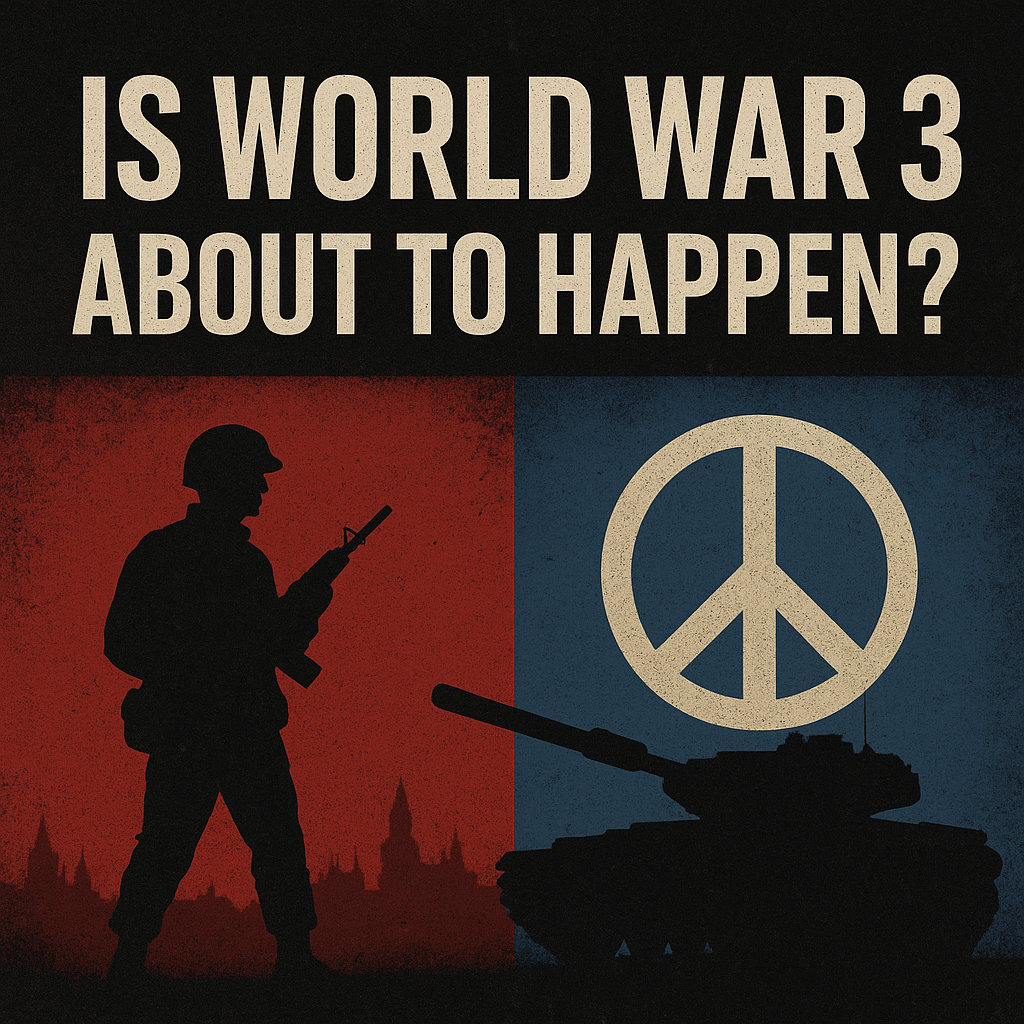Introduction to Global Tensions
In recent years, headlines have increasingly echoed one chilling question: Is World War 3 about to happen? As global politics grow more unpredictable and nations flex their military muscles, the world finds itself on edge. While we haven’t crossed the threshold of global warfare, the similarities to pre-war conditions of the 20th century are alarming.
From economic clashes and cyber threats to proxy wars and regional disputes, the modern world teeters on a delicate balance. With rising nationalism, competing superpowers, and declining trust in international organizations, the landscape is ripe for misunderstandings that could spiral out of control.
What Triggers a World War?
Historical Causes of WWI and WWII
Understanding what sparked past global wars can help identify today’s warning signs. World War I began with a complex web of alliances, nationalism, and the assassination of Archduke Franz Ferdinand. World War II was fueled by unresolved tensions from WWI, aggressive expansionism, and ideological extremism.
Modern Equivalents and Flashpoints
Today’s world is marked by similar triggers—military alliances, rising authoritarianism, territorial disputes, and global economic strain. One key difference is the presence of nuclear weapons and advanced technology, which could accelerate the pace and scale of conflict.
The Role of Superpowers Today
U.S. vs China Relations
Tensions between the U.S. and China are arguably the most critical bilateral dynamic of our time. Trade disputes, military
NATO and Russia Confrontations
The NATO alliance’s support for Ukraine, military expansions, and frequent exercises near Russia’s borders have provoked harsh rhetoric and military countermeasures from Moscow. Russia views NATO as a direct threat to its security, fueling a Cold War-like standoff.
The Russia-Ukraine Conflict
Timeline of Escalation
Since the 2014 annexation of Crimea and the 2022 full-scale invasion, the Russia-Ukraine war has become a symbolic and strategic battleground. The conflict has drawn in weapons, intelligence, and support from dozens of countries, increasing the risk of direct confrontation.
Global Implications
This war has shifted global alliances, strained energy markets, and led to renewed military commitments across Europe. It’s not just a regional conflict—it’s a flashpoint with global repercussions.
Rising Tensions in the Indo-Pacific
China-Taiwan Situation
China views Taiwan as a breakaway province, while Taiwan asserts its independence. With U.S. military support for Taiwan, any aggressive move from Beijing could trigger a larger conflict, potentially drawing in Japan, Australia, and NATO allies.
U.S. Military Presence in Asia
The U.S. has increased military cooperation with nations like Japan, South Korea, and the Philippines. Naval drills in contested waters are frequent, and both sides continue to boost military readiness, heightening the chance of miscalculation.
Middle East Flashpoints
Iran-Israel Dynamics
Tensions between Iran and Israel continue to rise, particularly over Iran’s nuclear ambitions. Proxy wars in Syria, Lebanon, and Yemen add fuel to the fire, making the region a potential ignition point for broader conflict.
Proxy Wars and Regional Instability
Groups like Hezbollah and the Houthis operate as extensions of larger powers’ influence, making it easy for small-scale attacks to escalate. The fractured political environment creates ongoing instability that could rapidly spiral.
The Role of Alliances and Treaties
NATO, AUKUS, and BRICS
Modern alliances like NATO and the AUKUS pact (Australia-UK-U.S.) offer security—but they also heighten risks. These commitments mean regional skirmishes could quickly globalize. Meanwhile, BRICS countries (Brazil, Russia, India, China, South Africa) seek to counterbalance Western influence.
How Modern Alliances Can Escalate or Prevent War
While alliances deter unilateral aggression, they also bind nations to react if one is attacked. This interconnectedness makes isolated incidents far more dangerous than they appear on the surface.
Cyber Warfare and Modern Threats
Cyberattacks have replaced bullets in many cases. State-sponsored hackers target infrastructure, financial systems, and democratic processes. These invisible battles can provoke military responses, blurring the line between peace and war.
Economic Warfare and Sanctions
Economic sanctions have become a weapon of modern diplomacy. Sanctions on Russia, trade wars with China, and oil embargoes affect millions and create ripple effects that stoke nationalist anger, recession fears, and political instability.
Nuclear Weapons and Deterrence Theory
Arms Race Developments
Several nations are modernizing their nuclear arsenals. The U.S., Russia, and China are all investing in next-gen delivery systems such as hypersonic missiles and stealth submarines. These technological advancements increase the speed at which a conflict can escalate—leaving less time for diplomacy or de-escalation.
Risk of Nuclear Miscalculation
One of the greatest fears is not a deliberate launch, but a miscalculation. Faulty intelligence, cyber interference, or even human error could result in catastrophic decisions. The “Doomsday Clock” by the Bulletin of the Atomic Scientists has remained perilously close to midnight, symbolizing just how close we might be to nuclear disaster.
Military Buildups and Exercises
Large-Scale War Games
Military drills such as NATO’s Defender Europe, China’s joint exercises with Russia, and India’s troop deployments near contentious borders serve dual purposes: readiness and deterrence. But they also heighten suspicion and anxiety, especially when conducted near rival territories.
Deployment of Strategic Assets
The placement of missile defense systems, aircraft carriers, and tactical nukes in foreign regions is another sign of escalating preparation. These moves are often mirrored by rival powers, creating a tit-for-tat escalation loop.
Public Perception and Media Influence
How Media Narratives Shape Fear and Nationalism
Media outlets often amplify political rhetoric and military actions, framing them as existential threats. This can cause panic, fuel nationalism, and pressure governments to act more aggressively than they might intend.
Psychological Warfare
Propaganda, fake news, and fear-mongering are potent tools in modern conflict. Nations engage in information warfare to sway both domestic and global opinion, sowing discord and mistrust across borders.
The Role of the United Nations and Peacekeeping
Diplomatic Efforts
The UN, through its Security Council and peacekeeping missions, plays a key role in de-escalation. From negotiating ceasefires to monitoring borders, its interventions have prevented wars before.
Failures and Successes in Conflict Resolution
However, the UN’s effectiveness is limited by the veto power of its permanent members. In cases like Syria and Ukraine, geopolitical deadlock has rendered the body unable to act decisively, frustrating peace efforts.
Early Warning Signs Analysts Watch
Geopolitical experts keep an eye on several indicators that may signal an imminent war:
-
Unusual military deployments
-
Disruption of diplomatic channels
-
Sudden reserve mobilizations
-
Mass emergency preparedness drills
-
Sharp spikes in defense spending
When several of these signs appear simultaneously, it raises red flags in the global intelligence community.
Experts Weigh In: Are We Closer Than Ever?
Many analysts agree we’re living in the most dangerous geopolitical climate since the Cold War. While some remain optimistic about diplomacy and economic interdependence preventing war, others caution that the lack of trust and increase in regional conflicts suggest we are inching dangerously close to a larger confrontation.
Think tanks like RAND, Chatham House, and the Carnegie Endowment have published studies expressing serious concern, particularly over flashpoints like Taiwan, the Baltics, and Iran.
How Prepared Are Nations?
Civil Defense Measures
Countries like Switzerland and Finland maintain well-developed civil defense infrastructure, including bunkers and emergency protocols. Others, like the U.S., have continuity-of-government plans but less public guidance.
Military Readiness and Public Drills
Nations are increasing military recruitment, holding more drills, and even revisiting Cold War-era strategies. While this boosts readiness, it also reflects the growing fear that a large-scale war could break out.
What You Can Do as a Citizen
Stay Informed
Follow trusted news sources, monitor government advisories, and avoid disinformation. Understanding global affairs reduces fear and promotes rational responses.
Emergency Preparedness
Have basic emergency supplies, understand evacuation routes, and stay aware of local safety protocols. This doesn’t mean panicking—it means being prudent.
Advocate for Peace
Support diplomatic efforts, vote for leaders who prioritize stability, and engage in conversations promoting de-escalation. Small voices add up in democracies.
Conclusion
So, is World War 3 about to happen? The honest answer is: not inevitably—but the risk has never felt more real. The interconnected nature of our world makes peace both more fragile and more precious. As citizens, leaders, and global stakeholders, it is our collective responsibility to remain vigilant, advocate for diplomacy, and prevent history from repeating itself.
FAQs About “Is World War 3 About to Happen”
1. What is the biggest current risk of World War 3?
The U.S.-China tensions over Taiwan and the Russia-Ukraine war are the most likely flashpoints.
2. Are nuclear weapons likely to be used in a future world war?
While unlikely due to mutual deterrence, the risk remains due to potential miscalculations.
3. What role does the media play in escalating conflict fears?
Media can amplify fears, misrepresent facts, and create pressure on governments to act aggressively.
4. Has the UN prevented wars before?
Yes, the UN has successfully de-escalated conflicts, but it’s limited by political deadlock.
5. What should I do if a global war seems likely?
Stay informed, prepare basic supplies, and avoid panic. Advocate for peace where possible.
6. Is there any hope for peace in today’s world?
Absolutely. Diplomacy, economic interdependence, and public advocacy continue to be powerful forces against war.
External Source:
Learn more from the Stockholm International Peace Research Institute for data on global military trends.



